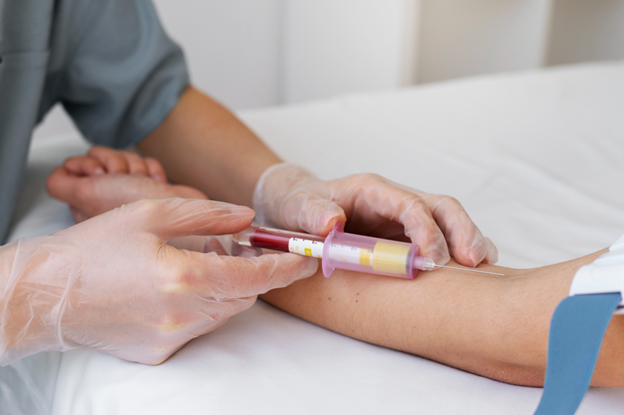In our journey to better health, understanding lab tests, like hemoglobin electrophoresis, is crucial. This test plays a vital role in detecting blood disorders, helping your doctor pinpoint health issues. Blood health provides insights into our overall well-being, and hemoglobin levels are key in this evaluation. Learning about this test enables you to actively engage in discussions about your health with medical professionals.
Hemoglobin is a protein that makes your blood red and helps carry oxygen throughout your body. Hemoglobin electrophoresis serves as a powerful tool in health diagnostics by allowing precise identification of the hemoglobin types in the blood. Knowing what the test is and how it works can aid in early diagnosis and treatment of conditions like sickle cell disease and thalassemia, ensuring you’re on the right track to maintaining optimal health.
Demystifying Hemoglobin — What’s in Your Blood?
emoglobin is the substance in red blood cells that carries oxygen. It ensures that your muscles and organs get what they need to keep functioning. Let’s dive into the types:
- Normal Hemoglobin Types: Hemoglobin A is the most common, followed by Hemoglobin A2.
- Variants: Some people have different types due to gene changes, like Hemoglobin S or C. These variants can cause health issues.
Specific conditions relate to these variants. People with sickle cell disease have Hemoglobin S, which can lead to deformed cells that block blood flow. Those with thalassemia might have missing or defective hemoglobin, affecting how effectively red blood cells work.
Understanding these variations helps doctors identify genetic conditions early. It allows for timely intervention and management of symptoms. Hemoglobin levels indicate whether your body is functioning well or if there’s a need for further investigation. The type and amount of hemoglobin can change due to genetics or environmental factors, making this test crucial for anyone wanting to ensure they are in good health.
The ABCs of Hemoglobin Electrophoresis
So, what is this hemoglobin electrophoresis test everyone’s talking about? Simply put, it’s a blood test that type your hemoglobin variants using electricity.
Here’s how the hb electrophoresis test works: 1. Blood Draw: A small sample is taken from your arm. 2. Lab Work: Your blood is placed on a special gel. 3. Electrical Charge: An electric current moves the proteins in your blood, separating different types of hemoglobin. 4. Analysis: Lab experts look at the separated bands to identify hemoglobin types.
Why might a doctor suggest this test? Hb electrophoresis is often recommended if you have a family history of blood disorders, symptoms of anemia, or if you are pregnant – a period when it’s referred to as the haemoglobin electrophoresis test in pregnancy.
The hemoglobin electrophoresis test is central to diagnosing conditions early and accurately. It’s a first step in a detailed plan to prevent or manage blood disorders, making it an essential health test.
Navigating the Lab Process: What Happens to Your Blood Sample?
Once that tiny vial of blood is collected, a fascinating journey begins. Within lab walls, your blood undergoes several processes:
- Collection: Specialists collect your blood, marking it carefully to avoid mix-ups.
- Separation: At the lab, a process called separation begins. Your hemoglobin components are divided using electricity.
- Visualization: The separated hemoglobin creates a unique band pattern.
- Analysis: Lab analysts compare these patterns against standards to spot abnormalities.
By comparing your test results to normal results, health professionals determine if there are any issues needing attention. This comparison can reveal whether your blood has typical or atypical hemoglobin. Knowing whether hemoglobin levels or types differ from the standard helps diagnose potential health concerns.
In labs, getting accurate results is crucial. Proper handling and precise examination allow reliable haemoglobin electrophoresis interpretation, providing a clear picture of your hemoglobin health.
Decoding Your Hemoglobin Electrophoresis Results
Received your results? Let’s break them down. Hemoglobin electrophoresis results consist of different bands indicating types of hemoglobin.
- Normal Bands: Show expected types like Hemoglobin A.
- Abnormal Bands: Might indicate variants like Hemoglobin S or C.
These results can tell if there’s a potential blood disorder. Always discuss these findings with your doctor. They will interpret them and suggest any necessary treatments. Well-understood results lead to better health decisions.
Understanding and acting upon your hgb electrophoresis test outcomes is vital. With informed guidance, you’re well-equipped to ensure any health issues are addressed early on.
Life After the Test: Embracing a Healthier Future
What comes next? Based on your results:
- Doctors might suggest further tests for deeper insights.
- Lifestyle changes or dietary adjustments can be recommended for better health.
- Genetic counseling may be an option if variants are detected.
Your environment and diet significantly affect hemoglobin levels. Engage with your healthcare team, who will guide you on dietary choices and environmental changes. Remember, maintaining good blood health is a journey that pairs medical guidance with proactive care decisions.
With the power of tests like hemoglobinelectrophoresis, you’re taking charge of your health and well-being. Stay informed and proactive, and always feel free to ask your healthcare provider questions. Your health is a lifelong journey—embrace it confidently and informed!
With every test and every professional visit, you’re learning more about yourself. Celebrate knowing you’re on the path to lifelong well-being, equipped with the knowledge to address changes proactively and wisely. Cheers to a healthier, empowered future!
Take charge of your health with SLP Diagnostics! Book your test today for accurate results and personalized care.


